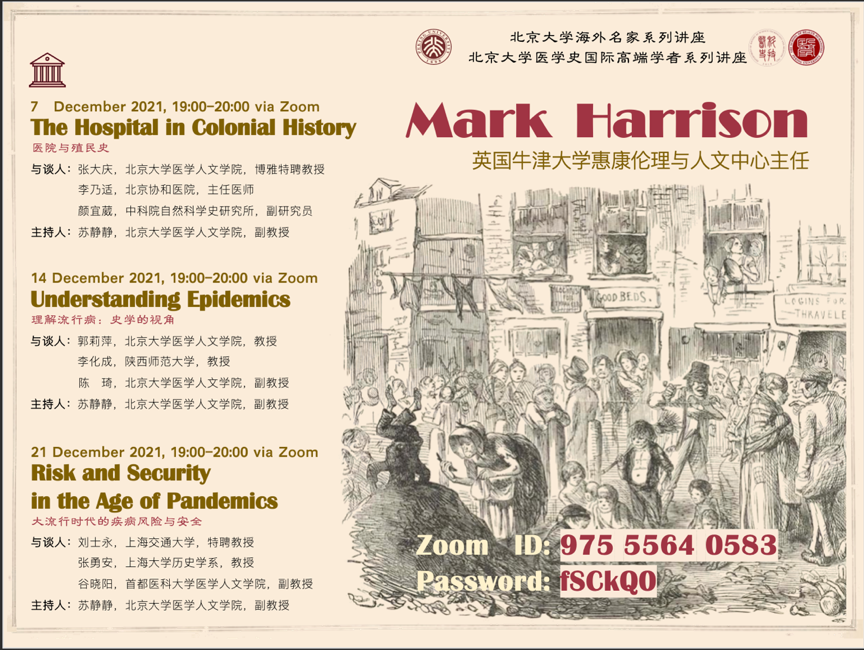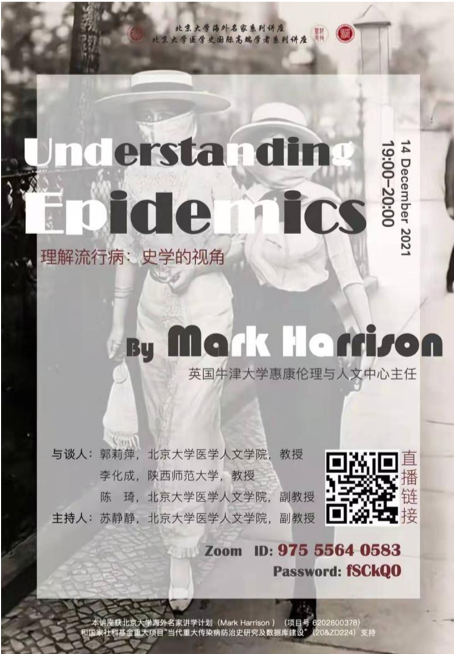Peking University Distinguished Lectureship & Global Health History Lectures: Prof. Mark HarrisonⅡ Understanding Epidemics: a Historical Perspective
With the support of Peking University Distinguished Lectureship (北京大学海外名家讲学计划) and Chinese National Social Science Foundation Major Project of the “ Contemporary Historiography and Database Construction of Epidemics ” (PI:Zhang Daqing), Professor Mark Harrison was invited to give a series of three online lectures around themes of great concern on the history of global health in December of 2021. Mark Harrison is the professor of history, co-director of the Wellcome Centre for Ethics and Humanities, University of Oxford, UK.
The series of Global Health History Lectures were chaired by Prof Su Jingjing, associate professor of the School of Medical Humanities of Peking University, and organized under the titles of “The Hospital in Colonial History” (December 7, 2021), “Understanding Epidemics: a Historical Perspective” (December 14, 2021) and “Risk and Security in the Age of Pandemics” (December 21, 2021), respectively.

On December 14, 2021, Professor Mark Harrison delivered the second online lecture—" Understanding Epidemics: a Historical Perspective ” via zoom. The lecture was chaired by Associate Professor Su Jingjing (苏静静) from Peking University. Moreover, three experts in this field were invited for the dialogue session, who are Guo Liping (郭莉萍), Professor from the School of Medical Humanities, Peking University; Li Huacheng (李化成), Professor from Shaanxi Normal University; Chen Qi (陈琦), Associate Professor from the School of Medical Humanities, Peking University.

1. Introduction
Prof. Harrison mainly focused on the changing idea of epidemics and how to understand epidemics from a historical perspective within the context of global health, especially the various ways of Western societies view and deal with epidemics.
2. What is an epidemic?
According to Charles Rosenberg, epidemics have a “dramaturgic from”, and the social form of an epidemic has “Four Act”.
The First Act is “ progressive revelation ”, i.e. at the very beginning, there is often denial to acknowledgement that something unusual is happening, however, with the development of the epidemic, there is a progressive acknowledgement and then an official acknowledgment. The Second Act is “ managing randomness ”. It is a search for meaning. People in most societies tend to ask questions about why is it happening, why is it happening to our societies, or why is it happening now. From these basic questions, people try to make sense of the epidemics, and over time, there are often different ways of interpreting this meaning. The Third Act is “ negotiating public response ”, which is the most complicated. It embraces everything from collective ritual (possibly religious rituals) to government action. It is what we today perceive as public health. In this phase, most societies decide to deal with the disease but in different ways, for example the repentance for sins in religious society, or the government and society taking action against the disease and treating the infected people in modern society. The Final Act is “ retrospection ”, which would be towards or after the end of the epidemic. In some cases, the epidemic is a test for our society and some aspects of the society would be affirmed. People would look back at their way to deal with the crisis and even lead to the construction of the new moral or political order following the epidemic.
3. How do Historians Understand Epidemics?
From a historical perspective, especially in the context of widespread COVID-19, Professor Harrison pointed out that the epidemics have a huge impact on all aspects of society. Severe epidemics can cause demographic change, such as the Black Death in New York from the 14th century. What’s more, epidemics can be agents of political change. More generally, epidemics are windows on to society and are seen as crises which tests social cohesion. In addition, epidemics are used as a way of looking at tensions in society that are normally latent, which are brought to the surface by the impact of the diseases. Recently, historians have begun to examine the cultural power of epidemics and some of the emotions, such as fear and anxiety, which are elicited during epidemics.
What impact does the epidemic have on society?
The factors that are involved can be separated into two tables, i.e. the biological factors, the social and political factors. In biological factors, case fatality ranked first, and followed by contagiousness, biological demographics, symptoms/after-effects and novelty. While in social and political factors, exposure (social inequalities) was in the first place and followed by government responses (such as government judgment, government resources); levels of trust in government, police, medical and public health staff; social cohesion or its absence.
Epidemics can be regarded as a test of cohesion. Since the 1960s, some historians have regarded epidemics as a test of social cohesion, and believed that epidemics tend to increase latent tensions, which sometimes erupt into violence. However, in modern times, social tensions are exacerbated by state intervention rather than the disease itself.
Pre-modern Epidemics and Modern Epidemics
In the pre-modern era, state responses to epidemics tended to be weak or even absent. The responses tended to relate to rituals, occasionally for the relief of the sick and the destitute. In this era, religious interpretations and rituals were main way of making sense of epidemics and organizing collective response. Social disorder tended to be caused by sections of society searching for scapegoats, which was sometimes spontaneous, sometimes organized or opportunistic. For instance, during the Black Death in medieval Europe, there was scapegoating of Jews. The elements of this behavior in pre-modern epidemics even persisted into the modern period. The ritual (and scapegoating) is still a feature of epidemics, even though responses are predominantly secular.
The era of modern epidemics is from 1800s onwards, and the most likely causes of disorder joining epidemics tend to be related to state intervention, or lack of interventions to prevent disease, rather than the disease themselves. In detail, the common causes of disorder include discrimination, perceived disproportionality and inconsistency of interventions, inequality of impact (immediate and secondary effects, e.g. shortages, income), heavy-handed interventions by state actors (e.g. doctors, police), cultural or religious insensitivity.
4.How do Western Societies View and Deal with Epidemics in Present Situation?
Nowadays, COVID-19 is no more an epidemic, but a pandemic. How do responses in pandemics differ from ordinary epidemics? Since the late 19th century, reference points have often been global rather than regional or local, and the notion of the “pandemic” emerged at this time. In pandemics, political rivalries between states and the actions of other states can shape what happens in national contexts. For example, there are a lot of competitions and the governments would emulate what other states are doing. There’s also rejection of other states models for various reasons. Moreover, the expectations of the population can also be changed by what happens in another country.
COVID-19 has impacted greatly on Western societies, and historians began to think about: What generalizations can we make about protest in the current pandemic? What are the similarities and differences with other pandemics? What can we learn from the experience so far that might help in future pandemics or at a later stage in this one? COVID-19 has highlighted inequalities in terms of lockdown and intensified inter-generational tension. Because of the measures by the government, young people in Western societies are being restricted in economy, education, and even freedom. They are at a disadvantage, but definitely to help older people, who would suffer most from the pandemic. In addition, social response to COVID-19 in the West has entangled with a number of issues. For example. It tends to trigger the emergence of a new social and political trend, inflame a lot of tensions, cause fractured societies (such as tribalism), intensify racial problems (such as the reappearance of Black Lives Matter demonstration, scapegoating of Asians, Jews and so forth). In addition, the lockdown has done harm to social economy and increase public unrest. Moreover, vaccination, the weapon to fight the spread of COVID-19 has also been protested by some people, and some even behaved completely have bizarre, like attacking 5G towers.
5 .Conclusion
According to Professor Harrison, COVID-19 has created immense disruption in Western societies. The reasons are as follows. Firstly, COVID-19 is a new disease. Its uncertainty is greater, and most governments have lacked the capacity to respond effectively or in a measured way. Secondly, the uncertainty has also made it difficult for the public to calibrate the threat (proportionality), and it would be problems when trust in government is low. Thirdly, COVID-19 inflamed existing tensions and tribalism. Fourthly, the strength and ultimately the weakness of these protests is that they lack effective or consistent leadership, because they are mostly inchoate expressions of anger and frustration. Last but not least, if acute disorder or protest becomes chronic unrest, such as because of slow economic recovery, all of the above-mentioned may change. Briefly speaking, a lot of things that historians have written about epidemics and their impact on society have been confirmed by the present situation.
During the discussion and Q&A sessions, Prof. Guo Liping, Prof. Li Huacheng and Associate Prof. Chen Qi also generously commented and contributed to the discussion according to their research fields. Prof. Harrison also patiently responded to the questions raised by the audience.
Professor Mark Harrison’s lecture was highly and widely appreciated. It was also demonstrated by live webcast on the platform of Bilibili, attracting more than 2000 audiences worldwide, and received encouraging feedback.
Yang Wenjun, Su Jingjing; School of Health Humanities


